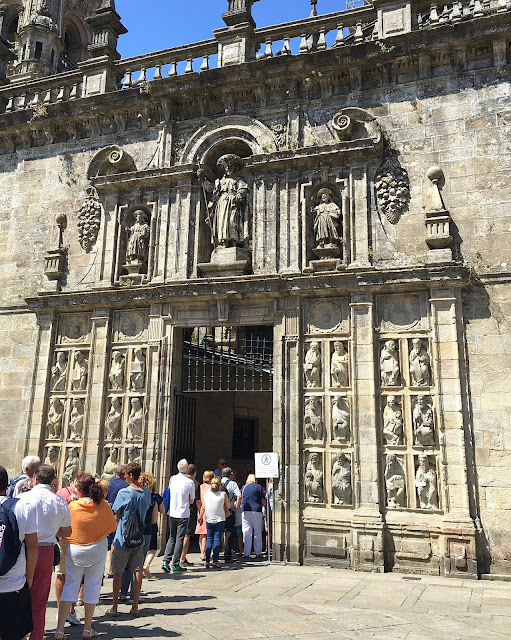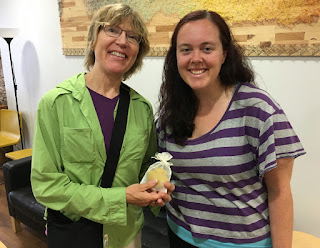Camino Primitivo
Exploring the Road in Asturias and Galicia
Saturday, October 1, 2016
Post Primitivo
It's now been a couple months since returning from Camino Primitivo. There's always time needed to process a Camino and reflect on the journey. For most of the route I walked alone -- pilgrims have their own pace and itinerary, so coordinating walking partners didn't happen often. I found walking solo through the "The Original Way's" lovely landscapes to be a peaceful & contemplative experience, and it gave me space to think. I thought about how lucky I've been to walk previous Caminos with Dad and to create the ex-votos we've left behind on all the journeys. I thought about the international community of people we've met and the lessons the Camino teaches -- especially last year when learning to 'pack light' made it much easier to downsize and let go of belongings after the flood where I live. And I thought about the centuries of the Camino pilgrimage tradition & its present resurgence. The concept of experiencing a 'walking journey' has indeed taken root and blossomed in modern times, from the Camino in Spain to the Pacific Crest Trail in the U.S. to other walking paths around the world gaining popularity.
The day after getting back to San Diego I received an email from a woman named Debbie who had heard one of my Camino presentations several years ago. It was at a local library & raining that day (unusual for San Diego!). Just a few people showed up, including Debbie & her husband who were interested in going on pilgrimage. I remember sharing information with them and talking about their travel possibilities. Three years later, she sent the message to let me know they were about to embark on a journey to Canterbury and Lourdes. Knee surgery and other things had been done first, and now they were about to leave.
Her note reminded me that the idea of going on a walking journey often takes time to percolate, as it had many years earlier after I first heard about the Camino. Seeds are planted, and the 'preparation journey' begins. It may require a period of time to get ready, but the 'call' has been sounded. The call becomes louder until plans are finalized, tickets booked, and finally feet hit the dirt. During this period there can be many people who contribute to the preparation -- family, friends, & mentors who participate in the process.
During the walk, I received the sad news that my graduate advisor, Fr. Michael Morris, had passed away. Fr. Michael was a Dominican priest and beloved professor whose passion for art and teaching inspired decades of students. In his iconography class I created my first ex-votos for the final class project and am grateful for his enthusiasm and encouragement during my studies. On the Primitivo, I often thought how much Fr. Michael would have enjoyed seeing the Camino's rich art history encountered daily. His 'pilgrim spirit' will be missed.
While piecing together the blog from photos and notes, I thought about the many memories that were made. I'm thankful for having had the opportunity to explore more of Spain and for meeting fellow walkers and Spanish locals who became my Camino community. The blog shows glimpses of the people, landscapes, art & architecture, animals, and ex-voto moments along the Road.
Until the path calls again, Ultreia et Suseia! Forward & Upward!
Sunday, July 31, 2016
To Madrid
On the way to Santiago's train station, I walked by Praza das Praterias, which was relatively quiet this time on Sunday. Praterias, translated as "silversmith" in Spanish, references the craftsmen's workshops located here during the Middle Ages. The cathedral's facade on this side features the only extant portals from the original Romanesque structure and where pilgrims coming from Portugal entered. Next to the doors stands the clock tower with a lantern that shines continuously during Holy Years to guide walkers into the city.
While waiting at the station for the 12:05 train to Madrid I saw other walkers likely leaving for home too.
Adios Santiago and Spain...hasta luego!
** Check out the Pilgrim Pouch's Primitivo journey
Saturday, July 30, 2016
Santiago, Ultimo Dia
On previous days crowds wound around the plaza waiting to enter the doorway as shown above. I walked over after breakfast when people hadn't arrived yet. Above the iron gate are St. James and disciples Athanasius & Theodore at his side; flanking the doorway are relief sculptures of figures from the Old Testament.
The back of St. James can be seen from inside the iron gate.
The entranceway leads to bronze doors that open up to the ambulatory, or walkway behind the altar. The doors weigh over 1,300 pounds and were installed in 2004 to commemorate the Holy Year. They have bas relief panels that depict important events in the life of St. James.
Gail, originally from Pennsylvania and now working at the Pilgrim House, took the shell and will add it to others brought by walkers in memory of Denise.
In the afternoon I toured the Cathedral's museum, which encompasses several different levels and birds-eye views of Praza do Obradoiro. Across the plaza is Pazo de Raxoi, the 18th c. neoclassical town hall and seat of the Galician government, or Xunta. It once housed a jail and was named after Archbishop Bartolome Raxoi, who had commissioned its construction.
On the north side of the plaza is Hostal dos Reis Catolicos, the parador where I had the free pilgrim meal on the first full day in Santiago.
Pilgrims, tourists, and locals make up the plaza scene.
In Arco de Palacio, the archway that leads into Obradoiro Plaza, musicians played Celtic inspired music with what looked like traditional Galician instruments. A group in regional costumes joined them. This spot often has musicians playing a variety of music, from bagpipers (reflecting Galicia's heritage) to classical selections. I've heard opera singers perform here too.
In the afternoon I saw them walking near the Cathedral, and later they participated in a fashion show of regional costumes held in Praza da Quintana.
The narrowest street in Santiago is Callejon de Entrerruas -- a man and 2 kids wide.
Dinner was at Casa Manolo, where a 5 star 2 course meal (plus dessert & beverage) is served at menu del peregrino prices. Dad and I ate here last year and enjoyed the festive atmosphere. This time I ordered Padron peppers for my primero course -- grilled just right and sprinkled with sea salt -- delicious.
The restaurant's owner, Manolo, has walked the Camino. He stamped my credential as I paid for the meal.
The last day ended with a stroll around Alameda Park that overlooks the city and Cathedral. The park's origins go back to the 16th c., and its gardens are the setting for many cultural and festival events.

Swans caught the attention of park visitors.
A bronze of Galician writer Ramon Maria del Valle Inclan seems to dare the viewer to sit with him. The sculpture was created by Cesar Lombera and installed in 1999. Valle Inclan was known for his long beard and enjoyed looking at the cathedral from this area of the park.
Friday, July 29, 2016
Santiago, Segundo Dia
For the last 2 nights in Santiago I moved over to Hospederia San Martin Pinario, the hotel and former Benedictine monastery complex adjacent to the Cathedral. The hotel's top floor has the "pilgrim rate" rooms much cheaper than regular accommodations. I've stayed here with Dad on previous walks too.
St. James greets hotel guests in the hallway leading to the lobby.
San Martin was built on the grounds of a structure that dates approximately 899, and by the 15th c. it had become the most powerful monastery in Galicia.
My room, complete with a
bathroom & big towel! The
window looked out over the city.
After getting settled at San Martin, I met with Ivar Renke at his office about a 5 minute walk away from the hotel. Ivar created and manages the popular Camino de Santiago forum & online store, Casa Ivar, which offers Camino related merchandise, including guidebooks, credentials, shells, T-shirts, and the Pilgrim Pouch.
Originally from Norway, Ivar attended Washington State University and spent time in Fort Collins, CO before moving to Santiago with his family. Since 2004 his forum has provided answers to walkers' questions and been an online arena for topics concerning the Camino. In addition to the online store, Ivar also provides luggage service for pilgrims who ship gear ahead while on the trail or for luggage to be used after the journey ends.
** The Pilgrim Pouch's adventures on the Primitivo can be found on Pilgrim Pouch Peregrinations.
After visiting Ivar, I walked over to Praza Praterias to see the Museo de las Peregrinaciones y de Santiago (Pilgrimage & Santiago Museum). The museum had moved into a new space since seeing it last in 2013. Exhibits present artifacts pertaining to the devotion of St. James and development of Camino routes during the Middle Ages.
Objects shown above include a 17-18th c. moulded enameled ceramic shell canteen, or cantimplora, from Valencia and also a shell-shaped ampulla from the 15th c. Ampullae were flask-shaped small containers for water or oil associated with saints' relics, or 'holy bones,' which were dipped into water with the thought of transferring healing powers to the liquid. Around 2" tall, the objects typically have an image of saints, shrines, or biblical scenes. Pilgrims would carry ampullae home with them as souvenirs or for healing purposes and were sometimes worn around the neck as pendants. Mass produced, they were made from clay or a lead/metal alloy and cast in 2-part limestone moulds.
Throughout the Middle Ages, ampullae were sold and collected at pilgrimage sites in eastern & western Europe and the Holy Land. This ampulla dates between the 4-8th c. & is from a potter's workshop in Alexandria (Egypt). The relief on the front shows St. Menas, an Egyptian saint known for healing illnesses & as a protector of pilgrims.
The museum's collection includes various depictions of peregrinos and St. James with his attributes -- cloak, walking stick, gourd, pouch, and hat with shell.
Fragments of a leather shoe from the 11-14th c. -- it would have been difficult walking a Camino wearing this kind of footwear!
The only surviving gateway of the medieval city wall is Mazarelos Arch in Praza Mazarelos.
Gelato fans at Limoncelli
The Flight of Egypt is depicted above the portal Portada dos Carros of the Convento de Sao Paio de Antealtares. The original Benedictine monastery building was founded in the 9th c. and looked after the tomb of St. James. The present Baroque structure is from the 17-18th c.
The Praza da Inmaculada (Azabacheria) in front of San Martin &
on the north side of the Cathedral
on the north side of the Cathedral
Many Spanish student groups were staying at Seminario -- above is a portion of one group that wore green shirts, green sock tassels, and brown ranger style hats. Wood walking sticks completed their trekking gear.
These hanging bucket lights looked festive.

Groups celebrate their journeys' end in Obradoiro Plaza.
A singer and guitarist performed at a cafe while their table companion directed.
In the evening at San Martin I got together with Julia from Paris, whom I'd last seen in Melide. Since then, she had gone to Finisterre and was returning home the next day. We chatted in the hotel's courtyard about our Caminos and how the journey can bring clarity and transformation. At a table nearby were members of a French Camino association in Santiago for a conference. One member from Paris, Adeline, is a medievalist and researches Camino and pilgrimage topics, including ex-votos. It was fun to finish the day sharing information and experiences.
Subscribe to:
Comments (Atom)






















































